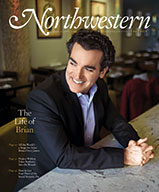Expanding LGBT Research
Tell us what you think. E-mail comments or questions to the editors at letters@northwestern.edu.
Find Us on Social Media
Feinberg launches HIV study in new community-based research center.
The past decade has seen steadily declining HIV rates for the broader population. Yet gay and bisexual men between the ages of 13 and 29 remain critically at risk: based on current trends, 40 percent of this group may have contracted HIV by age 40. It’s a problem that is reaching epidemic levels, says Brian Mustanski, a psychologist and director of the Feinberg School of Medicine’s IMPACT LGBT Health and Development Program and co-director of the new Third Coast Center for AIDS Research.

Feinberg professor Brian Mustanski leads Northwestern’s partnership with Center on Halsted. Photo by Michael Goss.
To combat the crisis and expand research on the LGBT community across a wide range of health issues, Feinberg opened a new health research center at Center on Halsted, the largest LGBT center in the Midwest. Unveiled in late April, the research center, which includes a biological and behavioral lab, represents the first time a major university has situated a biomedical research center within an LGBT community organization.
“It’s a comfortable space,” says Mustanski ’99. “It’s important to be doing research in a space that’s welcoming to the community and in partnership with the community.”
He is leading a new five-year study, funded by an $8.7 million National Institutes of Health grant, on the numerous factors driving HIV, including genetics, sexual partner and relationship characteristics and social networks. The study will follow participants for four years and include more than 1,300 young gay and bisexual men, many chosen from previous Northwestern studies or recruited by peer participants. Among the subset of participants who are HIV positive, the researchers will explore the evolution of the virus in Chicago.
The new research center’s location inside Center on Halsted will enable doctors to collect biological samples in real time and immediately connect study participants who test positive with the organization’s wide array of services, effectively “bridging the gap between science and service delivery,” Mustanski says.



 Facebook
Facebook Twitter
Twitter Email
Email


